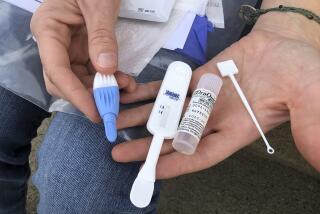AIDS Drug Program Treats 1 Million
Nearly a million people in developing countries are receiving drug treatment for HIV and AIDS, more than double the number 18 months ago, but global health officials acknowledged Wednesday that they would still fall short of their goal of treating 3 million people by the end of the year.
The increase in treatment was greatest in countries across sub-Saharan Africa, expanding more than 60% in the last six months to reach an estimated 500,000 people, according to a report Wednesday from the World Health Organization and the United Nations AIDS program.
Despite the progress, the global effort to provide lifeprolonging antiretroviral drugs to patients has been hampered by a shortage of trained health workers, a lack of robust public health systems in many countries and a persistent problem in raising money, the report says.
âProgress hasnât been fast enough,â said Jim Yong Kim, director of the WHOâs HIV/AIDS efforts.
The report is the latest update on the â3-by-5â initiative, a joint program launched in 2003 by the WHO and UNAIDS to provide antiretroviral drugs to 3 million people in developing countries by the end of 2005.
As recently as January, UNAIDS had stated that it believed its program was on track to meet its goals.
But the problems of battling AIDS in developing countries have proved to be more than officials expected.
âDrug delivery is a major issue,â Kim said. âThe volume of treatments is more than [some underdeveloped countries] have handled in almost any other area.â
Bernhard Schwartlander, an official with the Global Fund to Fight AIDS, Tuberculosis and Malaria, which provides money to the 3-by-5 initiative, added: âThereâs a huge potential for misuse. Before one moves the drugs to these countries, you need to make sure you have a building that can lock the door.â
The initiative is also facing serious financial problems, Kim said. It will take an estimated $45 billion to continue the program through 2007. Only $27 billion has been pledged by donor countries, leaving a shortfall of $18 billion.
Some AIDS advocacy groups were quick to place blame on the waning attention to HIV and AIDS around the world. The South Africa-based poverty relief group ActionAid International said in a statement Wednesday, âThis news is an indictment of leaders in rich and poor countries, who have failed to fully back this vital initiative.â
The group called for increased commitment by members of leading industrial nations.
The report estimates that 5.5 million people who are in greatest need of the drugs have yet to receive them. UNAIDS officials define people as needing the drugs when their HIV infection is advanced and they are likely to die within two years.
That number is just a fraction of the estimated 39 million people around the world infected with the human immunodeficiency virus, which causes acquired immune deficiency syndrome. In 2004, the number of new HIV infections and HIVrelated deaths reached record levels, at almost 5 million and more than 3 million, respectively.
The progress in sub-Saharan Africa, which is the main focus of the 3-by-5 initiative, has been enormous, but the report estimates that drug treatments are available to only about 11% of those most in need.
In contrast, nearly two-thirds of the 465,000 in need in Latin America and the Caribbean have access to the drugs.
The least progress over the last six months has been in North Africa and the Middle East, where only about 5% of the 75,000 people in need of drugs receive treatment, according to the report.
More to Read
Sign up for Essential California
The most important California stories and recommendations in your inbox every morning.
You may occasionally receive promotional content from the Los Angeles Times.










